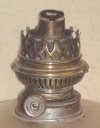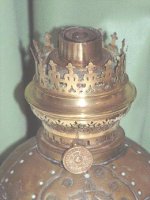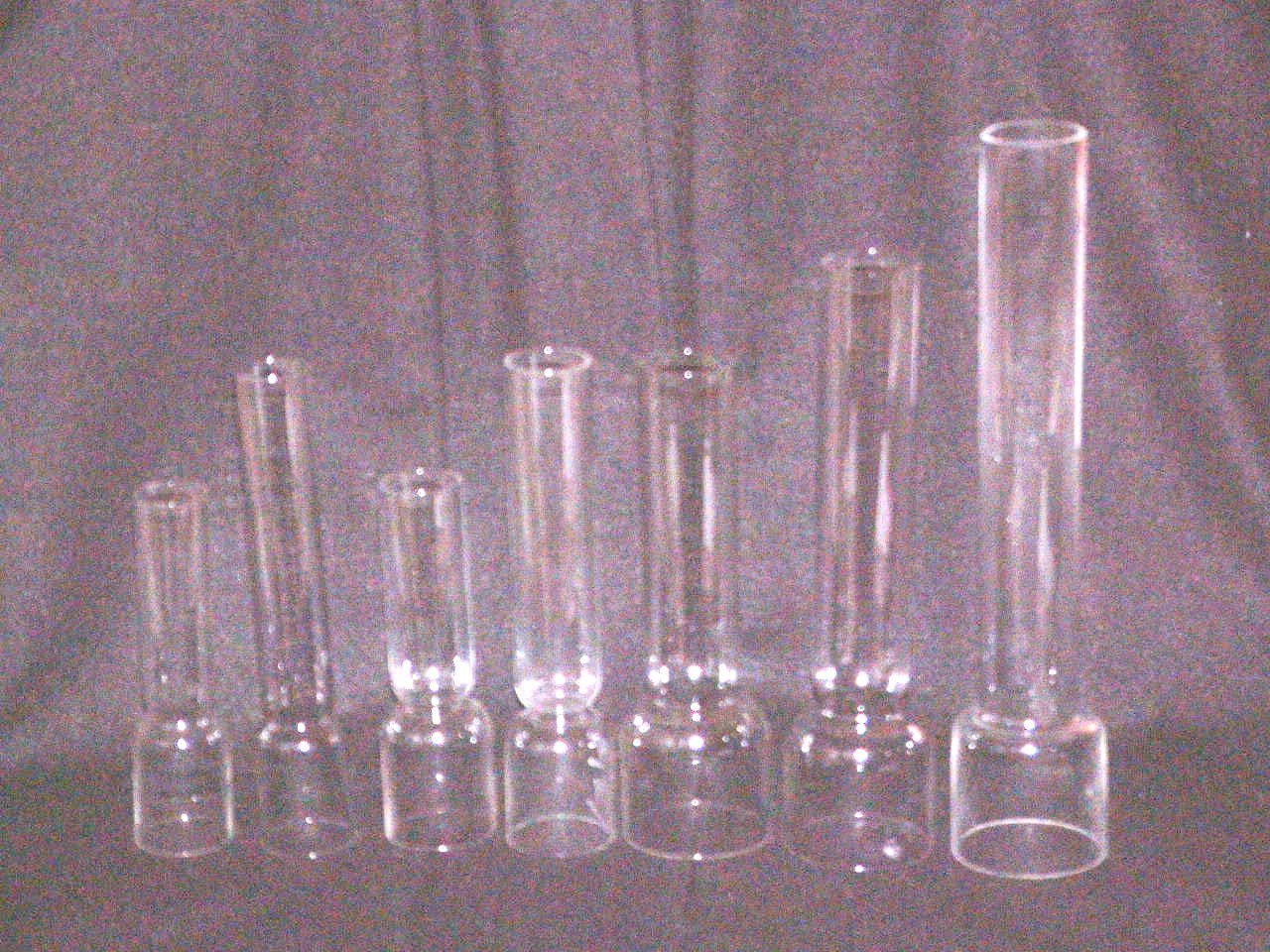-
The 'Kosmos' burner
The Kosmos burner is probably the most popular burner used in European lamps.A Patent for the design was first lodged in the UK in 1865 by Wild & Wessel from Berlin. In 1875 they began using the trade mark 'Kosmos' on winder knobs. The mark was taken over in 1899 by Brokelman, Jager & Co. who changed it to 'Kosmos Brenner', (literally 'Kosmos burner'), they contimued to manufacture right up to the 1970's when the factory closed and most tooling was destroyed.
A very popular burner in Germany and still manufactured today in France it has been used in all sizes of lamps from small hand lamps up to large table and hanging lamps
Despite the appearance of being a round wick lamp it is in fact a flat wick which forms into a circle as it passes through the burner. This clever design allows a large flat wick to fit into a small burner giving a good light compared to an ordinary flat wick burner of the same chimney size.
Many lamp burners, particularly the Kosmos type, are referred to in 'Lines', (abbreviated to three ticks ''' as opposed to the two ticks used to denote inches), and is a measurement of size. What are 'Lignes'?, click here to find out..!
Although the Kosmos burner uses a flat wick it is important that the wick is exactly the right width. Too wide and the wick will jam, too narrow and there will be a gap between the ends of the wick when it appears as a circle at the top of the wick tube. This will cause uneven burning, smell and blackening of the chimney.
Standard sizes of Kosmos burner were 6''', 8''', 10''', 12''', 14''', 16''' and 18'''.
The design of burner is referred to as 'side draught' because air is drawn into the burner through a triangular 'window' in the side of the wick tube and fed up to the inside edge of the wick. This allows the wick to burn much brighter than if air could only reach the outside edge. The burner can be fitted to a wide variety of founts, including decorative glass ones, because it does not require an air tube through the fount.
The correct chimney for this type of burner is the 'Kosmos' style, because the burner does not have a flame spreader, the constriction in the chimney directs air towards the wick and makes the flame into the tall form characteristic to this burner.
Left is a standard Kosmos burner, when shades were fitted to these burners the shade supports are soldered into the gallery. Older burners are often found with holes or cut stubs where the shade carrier has been broken in the past.
On the burner pictured left a short projection of brass rod can be seen on the right edge of the gallery where the shade carrier has been cut off.A 'close up of the Kosmos burner above.
Note the gap in the ends of the flat wick where it leaves the top of the wick tube.
The wick fitted to this burner is too narrow causing burning problems. The ends should just touch and look like a round wick at the top of the burner,
Left is a 'Reform' Kosmos burner, this modification of the Kosmos has an additional air tube which can just be seen in the centre of the wick tube. This air tube connects to the ring of slots around the burner on a level with the winder stem.
Some people make the mistake of thinking there should be a flame spreader fitted into the centre tube but a true Kosmos burner never has a flame spreader.
A selection of Kosmos chimneys showing the wide variation of sizes available to suit different styles of lamp.
HOW TO MEASURE A KOSMOS BURNER.
The most important measurement on a burner is the thread size where it fits into the fuel fount. The thread diameter for each burner size is :-
6 line = 25mm, 8 line = 28mm, 10 line =33mm, 12 line = 40mm, 14 line = 40mm
Antique burners had threads cut by machine but modern burners have rolled threads formed by crimping. This means modern burners fitted to antique lamps will be looser than the original. The burner must not be over tightened or it will keep revolving and the thread will be rounded off.
If you have the original chimney and it is the correct Kosmos shape as pictured above the often easier to simply measure the outside diameter of the chimney base to indicate the burner size.
6 line = 34mm, 8 line = 36mm, 10 line = 40mm, 12 line = 44mm, 14 line = 53mm
Measuring the wick is not a good way to identify a burner as the wick may have shrunk over time or the wrong wick may have been fitted in the past.
The correct sizes of wick for Kosmos burners is as follows:-
6 line = 35mm, 8 line = 41mm, 10 line = 48mm, 12 line = 54mm, 14 line = 65mm